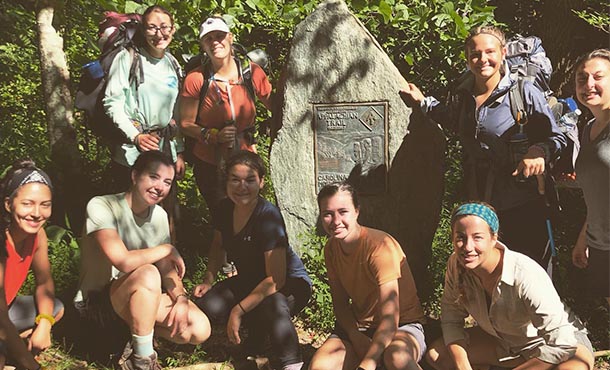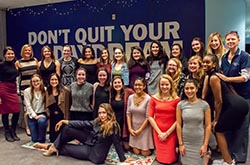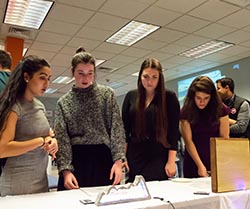
Led by Meg Handley, associate director of engineering leadership and assistant teaching professor, and Jessica Menold, assistant professor of engineering design and mechanical engineering, ENGR 497: Design Thinking and Resiliency provides female engineering students with experiential learning opportunities designed to help them succeed and lead during their engineering education and beyond. As part of the course, 21 female engineering students spent six days backpacking in North Carolina to build resiliency, self-leadership and efficacy in design thinking skills. IMAGE: PENN STATE
Design thinking and resiliency course builds confidence in engineering skills
Engineering Leadership Development and Engineering Design programs partner to offer experiential, women-led maker program
12/19/2019
By Samantha Chavanic
UNIVERSITY PARK, Pa. — As equity and inclusion become increasingly important in engineering programs across the nation, offerings that expose students to challenging experiences designed to increase self-awareness, confidence and engineering skills are needed more than ever.
Researchers in the Penn State School of Engineering Design, Technology, and Professional Program’s Engineering Design (DESIGN) and Engineering Leadership Development (ELD) programs used funding from the University’s Equal Opportunity Planning Committee to create ENGR 497: Design Thinking and Resiliency. Led by Meg Handley, associate director of engineering leadership outreach and assistant teaching professor, and Jessica Menold, assistant professor of engineering design and mechanical engineering, the course provides female engineering students with experiential learning opportunities designed to help them succeed and lead during their engineering education and beyond.
The two faculty members recruited 21 female students from BUILD Nights, maker events spearheaded by Menold, to encourage empowered building and making at the Learning Factory, for ENGR 497. Students who enrolled in the course completed a hiking course in summer 2019 to build resiliency, self-leadership and efficacy in design thinking skills. Upon completing this course, students applied to serve as Maker Ambassadors in support of the BUILD Night initiative.
During the summer 2019 hiking course, the 21 students, along with Handley and Menold, spent six days backpacking in North Carolina. Prior to the trip, students were required to read Brene Brown’s book “Braving the Wilderness” and Tom and David Kelley’s “Creative Confidence.” The trip presented students with physical and mental obstacles to overcome by working as a team and implementing engineering problem-solving skills. The experience combined with the pre-trip readings helped students to build resiliency and confidence in their creative abilities.
Lauren Matuszkiewicz, a senior in chemical engineering, said the experience presented her with many new experiences, as she had never been on an overnight hiking trip before.
“I really pushed myself, not only physically, but also mentally due to being with a new group of girls out in the woods somewhat fending for ourselves — making our own food and collecting our own water,” she said. “The trip did surprise me in the way I quickly bonded with the girls in my group because we were all going through the same hard times together.”
Imani Murray, a junior in materials science and engineering, was hesitant to enroll in the course because of its focus on hiking in the mountains. But because the course was designed for women engineers, she decided to take a chance.
“This experience was honestly one of the most challenging things I have done in a long time, maybe in my life,” Murray said. “Even though I was constantly tired, sweaty and sore, I got to experience beautiful scenery with amazing women who were all strong, powerful and wanting to succeed.”
While on the trail, Murray, Matuszkiewicz and the other students were presented with multiple engineering design and engineering leadership challenges, including designing a system to hang their bear bag, a bag which is hung in a tree and used to store food overnight; filling water filters; and forming hiking teams.
“We used all our group [experiences on the trail] to be leaders and inspire each other to keep going,” Matuszkiewicz said. “I think everyone on the trip had their own difficulties either physically or mentally, but together it made an experience in which we all felt comfortable with each other easily and were able to really open up to each other. This tends to happen when you are all struggling equally and have only each other to lean on.”
As a part of the course, students were assigned a secret user, another student on the trip, to observe while on the trail. The students would design and create a project that reflects what they learned through observing their user on the trail. Specifically, hiking groups completed activities that helped each other build empathy and understanding of another, a key element of successful design thinking.
After spending time hiking and collecting water with her partner, Matuszkiewicz learned of her partner’s love of space and NASA and her desire for more jewelry space. To reflect this, Matuszkiewicz created a rocket ship jewelry holder, cast from aluminum with a 3D-printed base.
Upon returning from the trip, the students spent most of the fall semester designing, prototyping and finalizing their projects. On Nov. 18, a gallery was held at Happy Valley LaunchBox for students to present their projects to their partners and event guests.
“The most important thing I learned from the course is that I can push myself way past the limits I thought I had,” Matuszkiewicz said. “I also learned that I am able to thrive in new environments. I personally cling to things that I am comfortable with and this trip really opened my eyes to all the new skills I could learn by pushing myself. I learned how to 3D print, cast metal, woodwork and metalwork.”
Like Matuszkiewicz, Murray used individual and group conversations to learn about her secret partner. After discovering the importance of family and friend relationships in her partner’s life, Murray chose to create a personalized modulated picture frame.
“Because of this trip, I was able to be more vulnerable with people I would not usually meet,” Murray said. “It was out of my comfort zone ‘artificially’ getting to know my secret user, but after stepping out of it, I felt very comfortable and things flowed effortlessly. It was exciting getting to know a stranger relatively in-depth, in an environment we are both new to.”
Both Murray and Matuszkiewicz encourage female engineering students looking to push themselves to become stronger and more confident engineers to enroll in the course.
“The most important things I learned in this course were about myself,” Murray said. “Before this trip, I did not know the heights of my strength. I did not believe I had resilience, yet the completion of the course told me otherwise. I came out of this experience with more confidence in myself, my design abilities and my future.”




